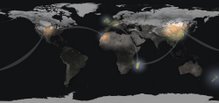The Rock and Pillar range scatters its tors all around. Bends in the gold-misering Otago Schist create crystallized lines of castles, frozen trolls, altars, tables, sphinxes, and wind-wrestled cock’s combs of stone. From the top of one block, dead hulks rise from dry grass spread below in all directions. For landscape’s life, you see the grass and plants and circling harriers. For inanimate lifelessly enduring earth, one imagines these standing rocks. Not so.
Each face and slab, every corner and alcove is covered. Every possible surface is occupied. Lived on. The earth here is coated entirely by replicating metabolizing colonizing cells. Lichen. At some point in history, a fungus offered to take its pet algae on a trip.
Fungus: "Listen, you chill out in this tiny aquarium between my cells, and I’ll show you the subaerial world"
Fungus: "Listen, you chill out in this tiny aquarium between my cells, and I’ll show you the subaerial world"
Algae: “Sounds good. Maybe you can stop subsisting on the rotting refuse of other life and consume my fresh photo-sugars instead. You could enjoy an ascetic existence in which you derive raw energy second hand from built-in solar collectors, and your trace elements from the face of bare rock, thereby acquiring the capabilities required to live practically anywhere on Earth."
Fungus: “Deal.”
Lichen is a form of husbandry. People of the Asian Steppe live on the ability of their animals to turn grass into human food. Fungi survive from the products of tiny sequestered plant blebs pumping out sugar. Assembled, the magic miniature lichen pairing constitutes both an organism and an ecology.
The sharp and heinous Tsingy in Madagascar is also covered with lichen. Millions of snails thrive tucked into corners between the spires. After seeing closeup photographs of the rock showing rasped tracks through the encrusting lichen, biologist David Haskell told me “To snails, those rocks probably look like they’re covered in peanut butter.”
And who doesn’t like peanut butter?
The sharp and heinous Tsingy in Madagascar is also covered with lichen. Millions of snails thrive tucked into corners between the spires. After seeing closeup photographs of the rock showing rasped tracks through the encrusting lichen, biologist David Haskell told me “To snails, those rocks probably look like they’re covered in peanut butter.”
And who doesn’t like peanut butter?


Ah, the radula. An opening into a new world of litho-lickin' goodness.
ReplyDelete